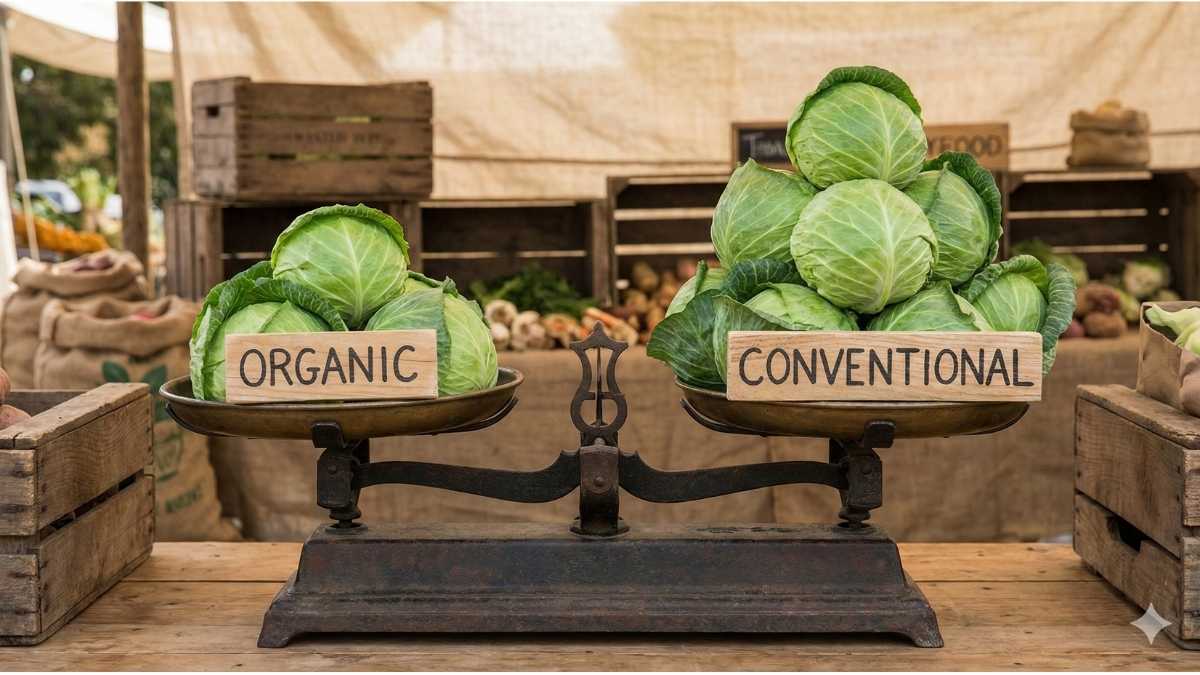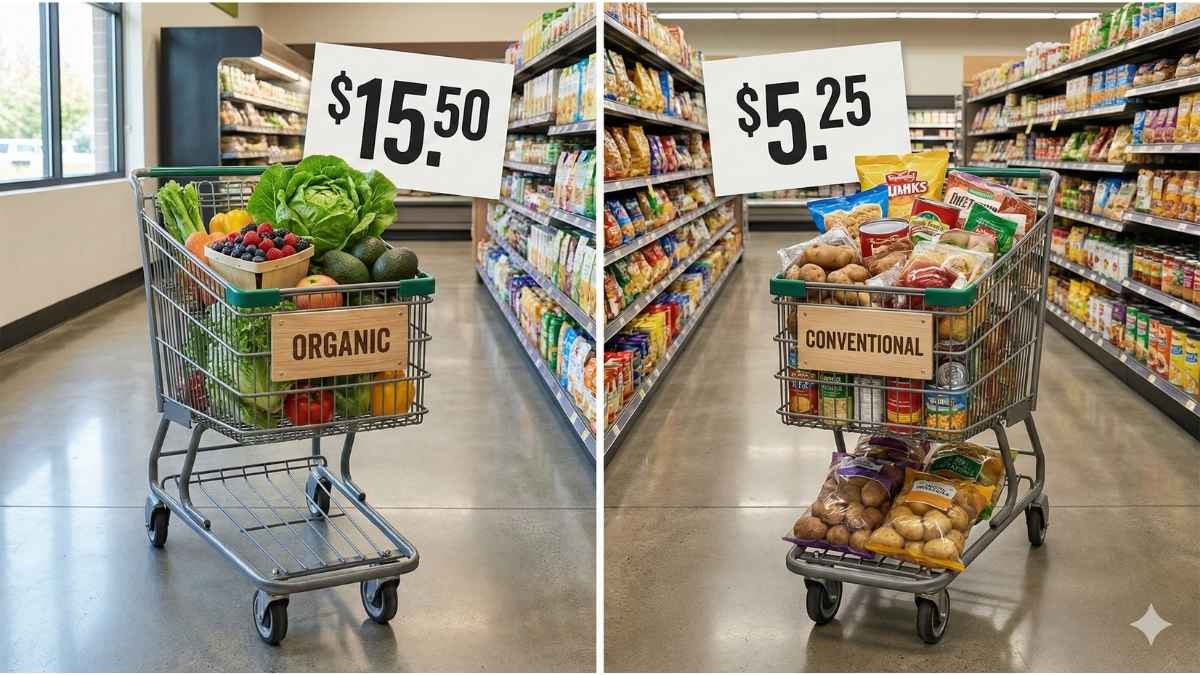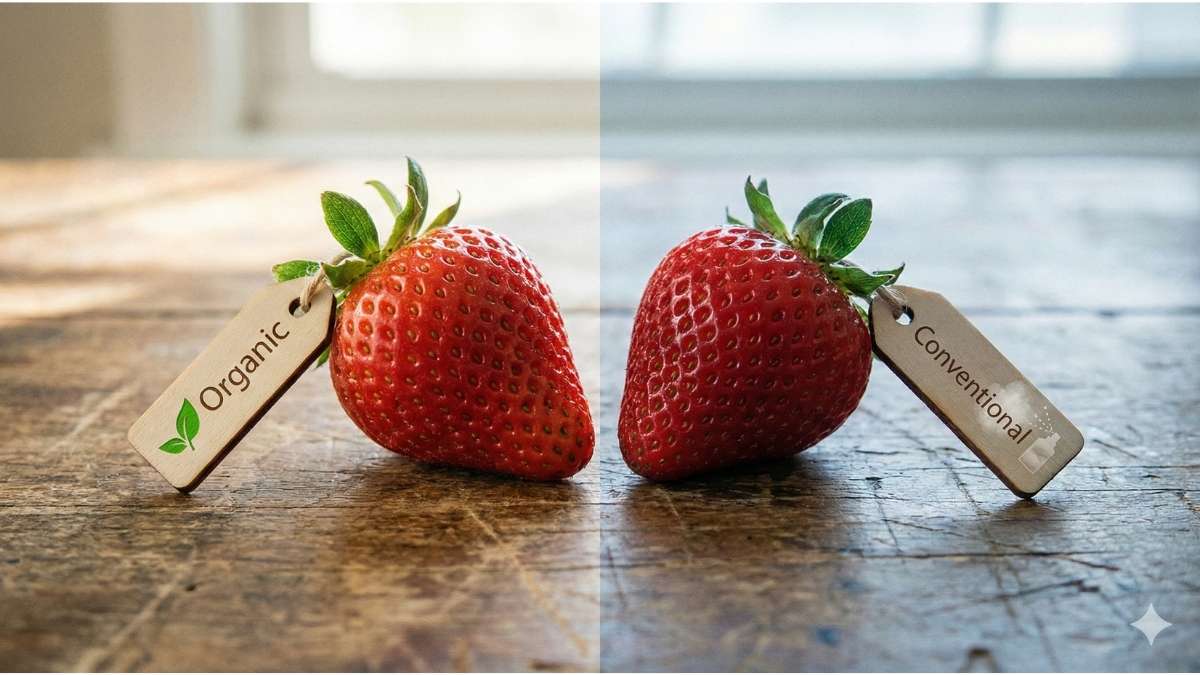Organic Food vs Non-Organic Food: The Complete Guide to
Strategic Buying Decisions (Safety, Cost, & Impact) ✨
The choice between organic and conventional food often feels like a high-stakes gamble between your family's health and your household budget. You’ve heard the conflicting reports: some say the nutrition is identical, yet the price difference can easily top 50%. Is the 53% price jump for organic strawberries really worth it? Or are you just paying for a label?
Let’s be honest. You are here because you need an answer that is both authoritative and practical. You need to know exactly when that organic premium is a strategic investment in your health and when it is simply a cost you can skip. My goal, as a PhD Student in agriculture who grew up on a farm, is to give you that confidence. We will cut through the marketing noise and look at the hard data.
The difference between Organic Food vs Non-Organic Food is not a simple nutritional issue. It is a calculated decision about risk management for your body, your wallet, and our shared planet.
CRITICAL TAKEAWAYS: YOUR SMART BUYING FRAMEWORK
- ✓ Pesticide Risk is the Key: Organic food's primary value is in significantly reducing your lifetime chemical burden, not providing superior nutrition.
- ✓ Master the EWG Lists: Focus 90% of your organic budget on the Dirty Dozen (highest residue items) and save big by confidently buying conventional for the Clean Fifteen (lowest residue).
- ✓ Strategic Meat/Dairy Buying: Choose organic animal products to actively avoid the routine use of growth hormones and unnecessary antibiotics, a critical public health concern.
- ✓ Slash the 53% Price Premium: Implement farmer-tested strategies like buying in season, using CSA programs, and buying bulk staples to make the organic choice affordable.
Defining the Stakes: What the Label Really Means
From an academic perspective, understanding the comparison between organic food vs non organic farming is crucial. The term "organic" is often misunderstood as a nutritional booster. It is not. It is a strictly regulated set of farming practices.
Organic certification (like the USDA seal) is a legal promise that the food was grown without key modern inputs: synthetic chemicals, genetic engineering, or irradiation. Growing up on a farm taught me that farming is a process, and the organic label validates the process, not necessarily the final vitamin count.
Natural vs Organic Food: Spotting the Gimmick
This is where consumers often get confused. The word "natural" on a package? That term is vague, lacks clear regulation, and essentially means nothing. A bag of chips can be labeled "natural" even if the corn was grown with synthetic pesticides and fertilizers.
If you are paying a premium for a label, make sure it is the Certified Organic label. That seal means the farm adhered to strict rules:
- No Synthetic Pesticides: Only approved natural substances may be used.
- Natural Fertilization: Relying on compost, manure, and crop rotation, not chemical fertilizers.
- Animal Welfare: Livestock must have access to the outdoors, be fed organic feed, and are prohibited from routine growth hormones or unnecessary antibiotics.
The difference in approach sets up everything we need to discuss: safety, cost, and environment.
🌱 Organic vs. Conventional Farming: A Quick Comparison ⚖️
Understanding the difference in farming practices drives smarter, healthier choices.
Safety First: The Strategic Case for Organic Food (Risk
Mitigation) 🧠
If you are worried about the impact of chemicals on your family's health—especially delicate tissues like the oral mucosa, which can experience irritation and inflammation from residues—this section is your priority. The single most compelling, data-driven argument for buying organic is the measurable reduction in exposure to synthetic chemical residues.
The core value of organic buying is not about adding something good; it's about eliminating something potentially harmful.
The Shopper’s Guide: Where Your Organic Dollar Matters
Most
Let's look at how to get the maximum safety benefit for your money. My research as a PhD Scholar suggests we must be strategic here.
You don’t need to buy every organic food. You just need to avoid the most contaminated conventional items. This is where the Environmental Working Group's (EWG) Shopper's Guide becomes your most powerful tool.
The guide divides produce into two critical lists based on comprehensive testing of pesticide residues:
The Dirty Dozen (Buy Organic Here! 🚨
)
These 12 items consistently test positive for the highest concentrations and number of different pesticide residues. This is where you should focus 90% of your organic budget.
⚠️ The 2025 Dirty Dozen List: Buy Organic! 🍎🐛
These 12 fruits and vegetables were found to have the highest pesticide residues. Prioritizing organic for these items is recommended.
Source Link: EWG's Shopper's Guide to Pesticides in Produce
The Clean Fifteen (Safe to Buy Conventional! 💰
)
These fruits and vegetables consistently carry the lowest detectable pesticide residues. They have naturally tough peels or growing conditions that minimize exposure. When you choose conventional items from this list, you are practicing strategic savings without compromising safety.
✅ The 2025 Clean Fifteen List: Buy Conventional & Save! 💰
These 15 fruits and vegetables were found to have the lowest pesticide residues. Buying the conventional version of these is generally considered a safe, budget-friendly choice.
Source Link: EWG's Shopper's Guide to Pesticides in Produce
Meat and Dairy: Antibiotics and Hormones
The debate for animal products is different from the produce comparison, which focuses on pesticide residue. For meat, eggs, and dairy, the key factor is pharmaceuticals.
As a student of agriculture, I want you to know that conventional farming often uses routine antibiotics and growth hormones. From an academic perspective, this is a huge public health concern because it contributes to antimicrobial resistance.
Organic standards ban the routine use of all unnecessary antibiotics and hormones. My hands-on experience shows that giving animals space and letting them live naturally reduces their need for drugs. Choosing organic meat and dairy is a powerful way to reduce your intake of these pharmaceuticals and support better animal stewardship.
The Nutritional Question: Separating Fact from Marketing
Myth
Here is the truth: The science on this is still emerging, but what we know so far is that organic food is not inherently more nutritious than its conventional counterpart.
The Power of Parity
Comprehensive meta-analyses, including major studies from Stanford University, show there is no strong evidence that organic food contains significantly higher levels of vitamins and minerals. You are still getting the same benefits in conventionally grown foods as you are in organic foods.
From an academic perspective: The nutritional content of any food depends much more on the variety of the plant, the climate, the quality of the soil (regardless of the label), the harvest time, and how long it’s been stored.
The Subtle Nuances of Organic Food vs Non Organic Foods
While overall vitamins are often equal, we do see subtle differences. My research suggests some organic produce may contain higher levels of phytochemicals—like antioxidants and polyphenols—or specific minerals, such as phosphorus.
Here is a way to think about it: Plants grown in organic fields face more natural stressors (like pests and weather) because they are not chemically shielded. They respond to this stress by creating protective compounds. This is why some organically grown leafy vegetables and corn grain show greater concentrations of specific minerals and vitamins. The core benefit, therefore, is not a vitamin spike, but a lower toxic burden over a lifetime, which allows your body to function more optimally.
The Danger of "Organic" Junk Food
This is important: Just because a package has the organic seal, it does not mean it is healthy. Many processed organic foods are still high in added sugar, salt, and calories. As your trusted friend, I advise you to check the nutrition label on an organic cookie with the same scrutiny you would apply to any conventional cookie. Focus on whole, unprocessed foods first, regardless of the label.
The Price Tag Problem: Deconstructing the Organic Premium
💵
 major reason organic food costs more is lower yield. Organic methods often result in 20% to 25% lower output per unit of land , directly translating to a higher price per item on the shelf.
major reason organic food costs more is lower yield. Organic methods often result in 20% to 25% lower output per unit of land , directly translating to a higher price per item on the shelf.The high cost is the reason you are skeptical. You are right to be. The latest data shows that organic fruits and vegetables cost an average of 52.6% more than their conventional counterparts. Some items, like iceberg lettuce, can be nearly 179% higher!
So, why are you paying so much more?
1. Lower Yields: This is the biggest factor. Organic methods, which avoid high-potency synthetic fertilizers, typically result in 20% to 25% lower output per unit of land. A farmer has to charge more per head of cabbage because he gets fewer heads from the same field.
2. Increased Labor: In my own home garden, I find that pulling weeds by hand or introducing beneficial bugs is far more time-consuming than just spraying a chemical herbicide. That increased labor cost is built into the price tag.
3. Certification Costs: Organic farms must pay for rigorous annual inspections and compliance checks to maintain their certification.
💵 Organic Price Premium: Smart Budget Strategy 🧠
Know when the premium is worth it and where you can save the most money.
Strategy is key to a healthy plate and a healthy bank account!
Mastering the Organic Budget: Practical, Farmer-Tested
Strategies 🥕
Now that we know when the organic premium is worth it (Section II), let’s focus on how to pay for it (Section IV). These strategies come from the field and the kitchen:
1. Buy In Season: This seems obvious, but it is the easiest way to save money and cut the carbon footprint. Out-of-season produce is expensive because of the high energy costs of importing it. My hands-on experience shows that a seasonal, local organic tomato tastes 100 times better than an imported winter one.
2. Precision vs. Bulk:
o Precision Buy: For items with a short shelf life, use local independent retailers to buy loose items and use your own containers. This saves on packaging cost and waste.
o Bulk Buy: For staples with a long shelf life—dried beans, grains, rice, quinoa, onions, and carrots—buying in bulk drastically reduces the cost per unit. You can split the large bags with a neighbor, too!
3. Direct Sourcing and Discounts:
o CSA Programs: Subscribing to a Community Supported Agriculture (CSA) box scheme bypasses distributor costs, delivering seasonal organic produce directly to your door at a better value.
o Look for Essentials: Many store-brand organic essentials are price-competitive with their conventional counterparts. Try switching the basics like bananas or simple cooking vegetables first.
4. The Online Pickup Trick: My research as a Trusted Friend of fellow busy parents suggests using "order online/pickup in store" options. You make logical decisions at home, avoiding impulse buys and in-store advertisements that trick you into overspending.
Beyond the Plate: Environmental and Ethical Stewardship 🌱
For many, the decision to choose between non organic vs organic foods transcends personal health and becomes a vote for the environment.
Soil Health and Biodiversity: The Long-Term View
As a PhD Scholar in agriculture, I believe this is the most compelling argument for organic. Conventional agriculture relies on synthetic chemicals that contribute to soil erosion and water pollution when nutrients run off into creeks and streams. Organic farming, by contrast, is recognized as a more sustainable practice.
- Soil Health: Organic methods like composting and crop rotation build soil organic matter. This allows the soil to hold more water during droughts, making the farm more resilient to climate change. You can think of healthy soil as a bank account; organic farming deposits back into it.
- Biodiversity: By excluding synthetic pesticides, organic farms allow beneficial organisms, wild flora, and fauna to flourish. Studies indicate that organic farms show a 30% increase in species biodiversity compared to conventional ones. This biodiversity supports crucial ecosystem services, like the bees that pollinate one-third of our global food supply.
The Ethical Dilemma: Yield and Land Use
It is important to embrace intellectual humility here. While organic farming is superior on a per-hectare basis (less pollution), the lower yields (20–25% less) mean that feeding the world organically would require converting more land.
This land-use change could potentially cause deforestation, which would release stored carbon, creating an indirect negative contribution to climate change. This complexity means we need balance.
We must support organic practices but also explore efficient, high-yield organic methods to meet global food demands.
Animal Welfare: The "Reality Gap"
Organic standards for livestock are generally higher: guaranteed outdoor access, organic feed, and no routine antibiotics. For dairy cattle, zero-grazing is banned, meaning cows must spend over 200 days a year grazing.
However, some advocacy groups have noted a "reality gap". Large-scale producers sometimes meet the letter of the law without meeting the spirit, offering minimal outdoor space. If animal welfare is your primary ethical driver, look for smaller, certified organic operations that visibly commit to genuine outdoor access and humane conditions.
Conclusion: Your Strategic Organic Decision Matrix
The high-value takeaway is simple: Organic buying is a strategic investment in risk mitigation, not a pursuit of superior nutrition. Stop aiming for 100% organic, and start aiming for 100% smart. By using this framework, you become a proactive protector of your family’s health and your financial stability.
🛒 Smart Shopping Guide: Organic vs. Conventional Priorities 🎯
Use this quick guide to decide where to spend your organic dollars based on **Safety**, **Budget**, and **Environmental Impact**.
Recommended Further Reading
Want to dive deeper into the science and data that guides these choices? We recommend these exceptional, high-authority resources:


